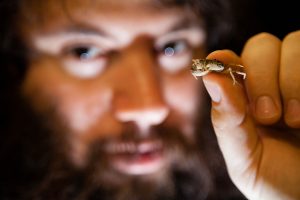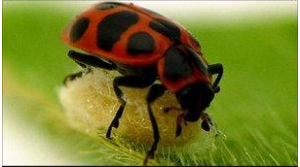Podcast: Play in new window | Download (Duration: 15:56 — 15.9MB)
We’re inching closer to Halloween and it’s getting spookier out there! This week let’s learn about some animals that get zombified for various reasons. This is an icky episode, so you might not want to snack while you’re listening. Thanks to Sylvan for the suggestion about the loxo and mud crabs!
Further reading:
Ladybird made into ‘zombie’ bodyguard by parasitic wasp
A mud crab held by a dangerous wizard:

A paralyzed ladybug sitting on a parasitic wasp cocoon:

A cat and a rodent:

Show transcript:
Welcome to Strange Animals Podcast. I’m your host, Kate Shaw.
It’s another week closer to Halloween, so watch out for ghosts and goblins and zombie animals! Zombie animals?! Yes, that’s this week’s topic! Thanks to Sylvan for suggesting the loxo parasite, which we’ll talk about first. Brace yourself, everyone, because it’s about to get icky!
Before we learn about loxo, let’s learn about the mud crab, for reasons that will shortly become clear. Mud crab is the term for a whole lot of small crabs that live in shallow water, mostly in the Atlantic or eastern Pacific Oceans but sometimes in lakes and other fresh water near the ocean, depending on the species. Most are less than an inch long, or under about 30 mm. The largest is called the black-fingered mud crab, which grows to as much as an inch and a half long, or 4 cm. Most mud crabs are scavengers, eating anything they come across, but the black-fingered mud crab will hunt hermit crabs, grabbing their little legs and yanking them right out of their shells. It also uses its strong claws to crack the shells of oysters.
Loxothylacus panopaei is actually a type of barnacle. You know, the little arthropods that fasten themselves to ships and whales and things. But loxo, as it’s called, doesn’t look a bit like those barnacles except in its larval stages. After it hatches, it passes through two larval stages; during the first stage, it molts four times in only two days as it grows rapidly.
Then, during the cyprid larval stage, the microscopic loxo searches for a place to live. The male remains free-swimming but the female cyprid larva is looking for a mud crab. She enters the crab’s body through its gills and waits for it to molt its exoskeleton, during which time she metamorphoses into what’s called a kentrogon, basically a larva with a pointy end. As soon as the crab molts its exoskeleton, the female loxo uses her pointy end, called a stylet, to stab a hole in the crab’s unprotected body. Then she injects parasitic material that actually seems to be the important part of herself, which enters the crab’s blood—called hemolymph in arthropods like crabs. Like most invertebrates, crabs don’t have blood vessels. The hemolymph circulates throughout the inside of the body, coming into direct contact with tissues and organs. This means that once the loxo has infiltrated the hemolymph, she has access to all parts of the crab’s body.
At this stage, the loxo matures into something that isn’t anything like a barnacle, but is an awful lot like something from a horror movie. She grows throughout the crab, forming rootlets that merge with the crab’s body and changes them. Basically, the female loxo becomes part of her crab host. Eventually she controls its nervous system and molds it to her own needs. She even molds the body to her own needs, since if she’s parasitized a male crab she has to widen its body cavity so it can hold her eggs.
The crab stops being able to reproduce and doesn’t want to. It only wants to care for the eggs that the female loxo produces. She extrudes an egg sac so that it hangs beneath the crab’s abdomen, where a male loxo can fertilize it when he swims by. The crab then treats the egg sac as if it contains its own eggs, protecting them and making sure they get plenty of oxygenated water. This is true even for male crabs, which ordinarily don’t take part in protecting their own eggs. The loxo eggs hatch in about a week, and as soon as they do, the female loxo inhabiting the crab starts the process over again. While a mud crab in the wild can live for a few years, once it’s taken over by the loxo parasite it only lives around 45 days.
Most mud crab populations are reasonably resistant to the parasite, but where the loxo has been introduced to areas where it didn’t live before, it can decimate the local mud crab population. This happened in Chesapeake Bay in the 1960s in North America. The local oysters had been so over-fished that they were nearly completely gone, also nearly destroying the local oyster industry. They imported oysters from the Gulf of Mexico to replenish local stocks, but no one realized they were bringing the loxo with those oysters. These days, up to 90% of the Chesapeake Bay mud crabs are infected with the loxo parasite, while only up to 5% of the Gulf of Mexico mud crabs are infected. Researchers at the Chesapeake Bay Parasite Project are working to figure out more about how the loxo infiltrates its host and changes it genetically, and are monitoring infection rates in the wild.
If you think that’s gross, it’s not going to get any better the rest of this episode.
Next let’s learn about another zombie animal, this one a spider. A number of spiders are parasitized by a tiny wasp called Zatypota percontatoria. It lives throughout much of the northern hemisphere and prefers forested areas with plenty of web-building spiders in the family Theridiidae, also known as cobweb spiders.
Cobweb spiders are really common with around 3,000 species that live throughout the world, including the black widow, which by the way is not nearly as dangerous as people think. Some cobweb spiders are kleptoparasites, which means they steal food and other resources from another animal, in this case larger spiders. A kleptoparasite cobweb spider actually lives in the web of a larger spider, and when a small bug gets caught in the web, it steals it. Sometimes the cobweb spider will kill and eat the spider that built the web in the first place too.
But most cobweb spiders are ordinary spiders, and most are quite small, usually only a few millimeters long. Many are marked with pretty patterns in brown, white, black, and other colors. Different species build different kinds of webs, but they all eat small insects.
As for the wasp, it’s about the same size as the spider it’s trying to parasitize, and sometimes smaller. It has long wings, long antennae, and a long abdomen that in the female ends in a sharp ovipositor. The female finds a spider, usually a young spider that’s less able to defend itself, and stabs it in the abdomen with her ovipositor. Then she lays a single egg inside the spider and flies away.
The egg doesn’t bother the spider, although once the egg hatches into a larva it starts to feed on the spider’s hemolymph. Remember, that’s the equivalent of blood in the invertebrate world. At the same time, it’s releasing hormones into the spider that change its habits. Basically the wasp larva controls the spider so that it acts to the benefit of the larva, not itself.
All this takes about a month. When the larva is ready to pupate and metamorphose into an adult wasp, it secretes a final hormone that influences the spider’s behavior. This one causes the spider to spin a strong, cocoon-like web. When the web is finished, the larva bursts out of the spider’s body, killing it, and eats the spider. Then it enters the cocoon and develops into an adult wasp.
Because spiders are good at defending themselves, only about 1% of spiders end up parasitized. I’m sure the spiders think that’s 1% too many. There are other parasitic wasp species in other places, but they all act about the same as Zatypota.
Another wasp, Dinocampus coccinellae, parasitizes ladybugs. Like Zatypota, the female wasp lays one egg in the ladybug’s body. When it hatches, the larva eats the ladybug’s insides while the ladybug continues to go about its ordinary activities. But after several weeks, the larva is ready to pupate. It paralyzes the ladybug, bursts out of its body, and spins a cocoon that the ladybug sits on.
But the ladybug isn’t dead. It protects the cocoon from other insects by twitching and making grasping motions with its legs.
After about a week, the adult wasp emerges from its cocoon and flies away. The ladybug usually dies, but not always. About a quarter of infected ladybugs recover and are fine. Researchers aren’t sure how the wasp larva causes the paralysis. It may release a virus that infects the ladybug or it may have something to do with venom released by the larva.
This wouldn’t be a proper zombie episode if I didn’t talk about that disgusting parasitic fungus that affects certain carpenter ants in the rainforests in Brazil and Thailand. It completely squicks me out so I’m going to explain it very, very quickly.
Fungal spores float through the air and land on an ant, where they stick. They release enzymes that eventually break down the ant’s exoskeleton, allowing the fungus to spread inside the ant’s body. Finally it’s able to control the ant and makes it crawl up the stem of a plant and bite into a leaf vein. The ant is unable to move at this point and eventually dies. The fungus sprouts from inside the ant and grows into stalks, especially from the ant’s head. About a week later it releases spores that go on to infect other ants. Ugh. So glad I’m not an ant.
Ants can sense when one of the colony has contracted the fungus, and will carry the infected ant far away from the colony so it’s less likely to infect others. The ants also groom each other to remove any spores that may have attached. The fungus can completely destroy ant colonies, but it has a parasite of its own, another fungus that stops the first fungus from releasing spores. A related parasitic fungus also infects certain caterpillars.
Look, I’m totally over talking about fungus, so let’s move on.
So is there any chance that a parasite will turn you into a zombie? There’s not, but a behavior-changing parasite does sometimes infect humans. It’s called Toxoplasma gondii, and while its effects on human behavior has been studied extensively, the effects are so minor as to be nearly nonexistent in most cases.
Toxoplasmosis is a disease caused by a single-celled parasite, and it’s one that not only infects humans, it’s really common. I probably have it but I’m not going to think too hard about that. For most people, it never bothers them and never causes any symptoms, or only mild short-term symptoms like a lowgrade cold that takes a few weeks to clear up. But it can be more serious in people with a suppressed or weak immune system, and can cause problems for the baby if its mother gets infected while she’s pregnant.
There are estimates that up to half the people in the world are infected with toxoplasmosis but never know. The reason it’s so common is that the parasite targets cats, and can be spread in cat feces. And, you know, if you scoop out the cat’s litter box you might be exposed. That’s why pregnant women shouldn’t clean up after a cat. Infection can also result from eating undercooked meat from an infected animal, eating unwashed fruit or vegetables, drinking unpasteurized milk, and drinking untreated water.
Any mammal or bird can contract the parasite, but it can only reproduce in a cat’s digestive system. It doesn’t hurt the cat, it just wants to get inside the cat so it can reproduce. And the best way to get inside a cat is to be part of a rodent that a cat eats.
When a rat or other rodent is infected with Toxoplasma gondii, its behavior changes. Suddenly, it starts to like cats. You can probably see where this is going. Not only does it stop avoiding cats, it actually seeks them out. The cat, naturally, can’t believe its luck, kills and eats the rodent, and may become infected.
If you have a pet cat, the best way to reduce the risk of contracting toxoplasmosis is to scoop the litter box daily, then wash your hands. It takes about a day for the parasite to become active after being shed in cat poop, so if you scoop the litter box right away the risk is lower. Researchers are working on vaccines, and they’ve actually already developed a vaccine that’s now used in sheep. If you keep your cat inside, where it’s safer anyway, it’s much less likely to be exposed to the parasite in the first place.
So, take ordinary precautions but don’t worry too much about toxoplasmosis. Unless, of course, you are a rodent.
You can find Strange Animals Podcast online at strangeanimalspodcast.blubrry.net. That’s blueberry without any E’s. If you have questions, comments, or suggestions for future episodes, email us at strangeanimalspodcast@gmail.com. We also have a Patreon if you’d like to support us that way.
Thanks for listening!